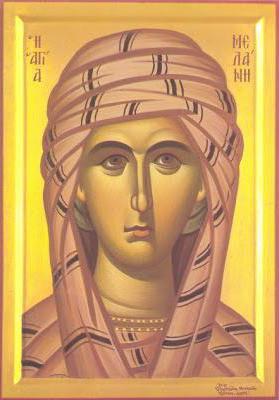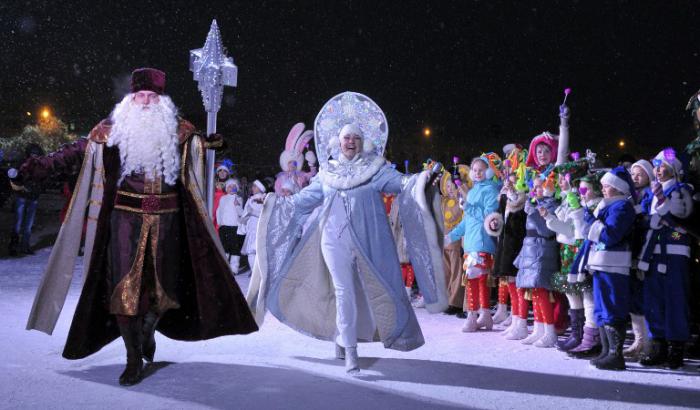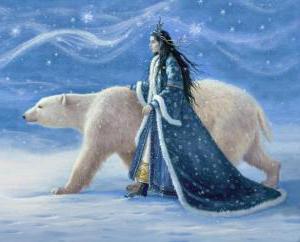However, in moments of philosophical mood, questions begin to arise in my head: why new Year in several countries they celebrate twice and where did this unusual folk holiday come from?
How the New Year appeared on the calendar
To celebrate the New Year on January 1 in the Russian Empire began only in 1700. Before that, there was no organization - the New Year was celebrated throughout the country on various dates. Someone continued to do this in March on the day of the vernal equinox, and someone continued on September 1, the date adopted in the state in the 15th century.
The initiator of the introduction of a single day of the beginning of the year was the founder of many innovations - Peter the Great. By decree of the sovereign, it was ordered to establish January 1 as the first day of the year and celebrate this day festively, congratulating all those close and simply oncoming. The king commanded people to decorate the Christmas tree, give each other gifts, have fun and rejoice. The decree also said that on New Year's holidays people should not abuse strong drinks and do not cause massacre.
Of course, such a tight framework initially provoked indignation among the people, but after a whole week was declared non-working, the residents of large and small cities calmed down and quickly fell in love new holiday. At night in honor of the beginning of the new year, bonfires were burned, fireworks were organized, songs were sung, and musical instruments played.
By the way, the custom of decorating the Christmas tree was borrowed from the Gentiles. Ancient people decorated conifers on the longest night of the year. They hung gifts and ribbons on fir branches, trying to appease the spirits and beg them for a good harvest, well-being and health. The fun tradition of dressing up in carnival costumes has the same roots - the pagans changed their image in order to hide from unclean forces descending to the earth on New Year's Eve.
Why the New Year's Day has changed
The shift in the start date of the year in Russia occurred due to the transition from the Julian calendar to the Gregorian calendar after the revolution. The difference between the two calendars is 13 days - exactly that much time and passes from the day of the celebration of the official New Year to New Year's Eve in the old style.
Perhaps the transition to new calendar would have forever changed the start date of the year, and no one would have recalled that it was once celebrated on another day. However, the Russian Orthodox Church opposed the transition to a new reckoning, adopted by the Bolsheviks in 1918, and continued to live according to the Julian style. For this reason, all church holidays and important dates have shifted.
Traditions in modern times
The old New Year is becoming more popular with every decade. Of course, this holiday is not on the calendar, and it is unlikely that it will ever appear on it, but people gather on the night of January 13-14 at a table set, give each other presents, pronounce toasts and congratulations. In many houses, before the New Year's Eve, decorated Christmas trees and holiday decorations are not removed. On television that night, they repeat New Year's programs and traditional films.
Christmas fast Christians cannot afford New Year's Eve modern style. For them, the Old New Year is the only chance to set a delicious table with delicious snacks and meat dishes.
According to church customs, special porridge is cooked this night. All family members take part in the preparation, and in the morning they eat it for breakfast at the common table. This custom, as well as walking on New Year's Eve by guests, came from the Old Russian calendar, when Vasily's Day was celebrated on this date.
Interestingly, the New Year’s date for julian calendar in a century that is not a multiple of four, it is put off by one day. Based on this, from 2101, New Year's Eve in the old style will have to shift to January 14th. Will there be such a shift in the people, and when people will celebrate the second new year, time will tell.
Which countries celebrate the old New Year
Some are sure that the tradition of celebrating the New Year in the old style exists only in Russia and the Slavic countries that were part of the Soviet state. This is actually a fallacy. The Old New Year is celebrated magnificently not only in Belarus, Ukraine and Moldova; it is adored in Serbia, Montenegro, Macedonia, Switzerland, Georgia and Armenia. Do not forget to celebrate the beginning of the new year according to the Julian calendar, some residents of the Baltic countries, Azerbaijan, Kazakhstan and Uzbekistan.
The Berber calendar, which is held by the inhabitants of Morocco, Tunisia, Algeria and some other countries, celebrates the beginning of the new year on January 14. It is known that their calendar is largely similar to the Julian one, but is slightly biased due to errors accumulated over many years.
When the New Year and Christmas were behind, fireworks and crackers died out, plentiful fun feasts ended, and the "long" holidays finally came to an end, there was still another strange holiday ahead, for the "snack" - the Old New Year. Many Russians, even not knowing what its essence is, do not forget to celebrate it - in order to extend their holidays. The history and traditions of the Old New Year were studied by the correspondent.
History with calendars
Julius Caesar, seized power in ancient Rome, in 45 BC. e. for ease of control of his power introduced a new calendar. An ambitious and military genius, relying on the most perfect administrative and military system in his time, he could not even imagine that a few centuries would pass - and the “eternal” Roman Empire will go down in history, and its chronological system, developed by scientists - Alexandrian astronomers led by with sage Sozigen, every 128 years he will accumulate an extra day and will eventually become obsolete.
The Julian calendar owes much of its fall to the triumph of Christianity. By the sixteenth century, pious Catholic astronomers became convinced that the feast of the Nativity of Christ, which initially coincided with the day of the winter solstice, began to shift more and more toward spring. As a result, in 1582, Pope Gregory XIII, who became famous not only for the brutal persecution of Protestants, but also for his scholarship, ordered the introduction of a more accurate calendar, named after him - Gregorian.
The spiritual flock of the Roman Catholic Church quickly accepted the innovation. Protestant Europe resisted for a long time, but mainly because of the spirit of contradiction to the papal throne - the convenience of a new calendar was also recognized there. The longest conservative British and Swedes lasted until 1752, but in the end they also surrendered.
No wonder the Russian Empire was proud of the title of the Third Rome - it was faithful to the Roman Julian calendar to the end. However, after the October Revolution, the decree of the Council of People's Commissars of January 26, 1918 unified the system of chronology in Russia with the whole world. Only the Russian Orthodox Church, not obeying the godless Bolsheviks who had excommunicated it from the state, remained faithful to the Julian calendar. So the Russian phenomenon of the New Year holidays arose - Christmas after the New Year and the tradition of celebrating the Old New Year from January 13 to 14, that is, according to the “old style”, as an integral part of our New Year saga.
Vasiliev day

The Old New Year holiday owes its appearance both to the indestructible habit of Soviet citizens to find an occasion to celebrate something with a fun feast, and to folk ritual and religious traditions related, in particular, to the church holiday - the day of Vasily the Great, falling on January 14 of the old style. It is no secret that in Russian folk customs, especially peasant ones, Christian rites are inextricably and organically intertwined with pre-Christian heritage.
The Christian saint of the late Roman era, religious philosopher and writer, Archbishop Vasily of Caesarea was called by the Russian peasant Vasily Solnovorot, which is associated with the winter solstice, and Basil the pig-breeder - the patron saint of pig farming. Vasily’s day falls at the end of a strict Christmas fast (November 28 - January 6), during which believers refrain from New Year's festivities.
The day of veneration of St. Basil fits into Christmas Christmas time - 12 merry days between Christmas and the Baptism of the Lord, when it is not forbidden to rejoice and have fun, as well as talk at the holiday table. Therefore, on this day, as a tribute to Vasily the pig, the decoration of the meal as usual was a baked pork head, a fried pig or other pork dishes, and in the houses it is worse - cookies in the form of pigs or other livestock.
But an interesting folk rite among the Slavs - sowing or sowing, performed in the Orthodox countries on January 13-14, has clearly pre-Christian roots and is confined to the winter solstice, when the sun "turns to spring" and means appeasing the future sowing and harvest. Hence the other, common name of Vasiliev’s Day in Russian peasant life - Ovsen, as well as Busen and Tausen in Ukraine and Belarus.
The ceremonies of grain growers are associated with the cult of grain as a guarantee of well-being and survival of the peasant community. Today, they are primarily preserved by the reenactors of folk traditions, but a hundred years ago they were honored in every large patriarchal peasant family from the Bug and the Carpathians to Siberia. The festival was opened by children, a symbol of spring and procreation, who went home and “sowed” grain from a sleeve or from a bag with the adage: “For good luck, good health, a new summer, give birth, God, live, wheat and all arable land”. The mistress of the house - “Bolshuha” - then collected this grain in the apron, and it was they who opened the spring sowing.
From the evening of January 13, in a new style, festive cereal was put in the house, usually buckwheat, which was not only a treat for the festive table, but also a means of divination for the future harvest and well-being of the house. Dressing in clean elegant shirts and praying, the senior man and the oldest woman in the family went to work. He brought water, she took out grain or groats from the barn, melted the stove and made porridge with the corresponding sentences and melodies. The younger members of the family watched the ritual in reverential silence so as not to scare away Zhitsen, the pagan ancient Slavic spirit of life, the patron of grain growers, from the house.
When the "magic" brew rattled, he was hoisted on the table and carefully examined. If porridge “escaped” - wait for trouble “over the edge”. A cracked pot did not bode well. If the grain is harsh - the economy is at the very least, but it will last. In the case of a negative prognosis, the porridge was thrown into the river. And if the porridge is a success, the harvest will be good, the family will prosper, and the treats can be served at home.
Caroling and Shedding
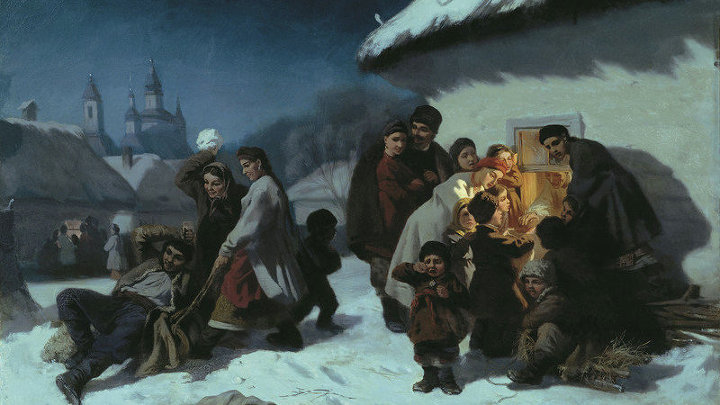
Carols
In the evening, on Vasilyev’s Day, young people went to the caroling village. Since the original meaning of this holiday was a spell of generous harvest, it was also called - to be generous. The Ukrainians and Belarusians this evening got the name Generous.
Some scholars of folklorists find the refreshes of “Vasiliev's bounties” even more diverse than those of Christmas carols, and they see echoes of pagan ritual chants in this. However, the Christian patron of this day, Saint Basil, is not forgotten in them: “Give a pig and a hog for Vasiliev’s evening.”
The owner had to bestow the throaty midnight singers as plentifully as possible with refreshments and small money, not only so that they could quickly get out to yell to the neighbors, but also the good fortune in the field work and harvesting did not turn away from him. There is a march on Vasily’s Day and a march with the mummers, which in many regions is specific. Pan-Slavic mummers - “goat”, “wolf”, “tour”, “bear” - are accompanied, for example, in some areas of Belarus by a beautiful elegant girl - Generous, and in Ukraine - Vasil and Malanka.
At night, on the New Year’s Eve, fortunetelling is also made of the girls divining on the narrowed - on nutshells, on scallops, on coals, on pies, etc., although this custom applies to the entire period of Christmas time.
The tradition of “generosity” and harvest spells on New Year’s Eve exists among all Slavic and most European peoples in various forms. At the same time, among Catholics and Protestants, as well as in some foreign Orthodox, it is tied to the Gregorian calendar.
Old New Year in other countries

Winter Belgrade
In addition to the Russian Orthodox Church, a number of local churches - the Jerusalem, Georgian and Serbian Orthodox churches, the Ukrainian Greek Catholic Church, several ancient Eastern churches, including Ethiopian, etc., remain faithful to the Julian system of chronology. The traditions of celebrating the Old New Year and St. Basil on January 13-14, preserved in a number of countries, are associated with this.
Serbs even call the Old New Year Serbian (Srpska Nova Godina). By the way, despite the historical popularity of pig farming in Serbia, Vasiliev Day among Serb peasants is considered a “professional” holiday not of swineherds, but of cheese makers. The holiday is also accompanied by a procession of mummers - young guys depicting a comic wedding procession. In some parts of the country, it is customary for Vasily the Great to bring “bad apple” into the house — an intricately decorated bouquet of oak branches or just an oak log, which is prepared for Christmas and burned on Christmas Eve in a hearth or on a fire.
Of course, such lovers have a tasty meal, like Serbs, Vasilyev Day is not complete without a culinary “specialty”. On the table are served “basilitsi” - delicious corn pies with kaymak - thick curd cream, as well as “in pairs” - a dish of corn bread, filled with hot milk with the addition of feta cheese, butter and olives.
The Old New Year is also celebrated in Macedonia and occasionally in Bulgaria, but there it is rather a custom adopted from the Russians in the era of socialism. In addition, in Western Europe on the night of January 13-14, not only people from the former USSR sit down to celebrate. Residents of the Swiss semi-canton of Appenzell-Inneroden, severe Protestant highlanders, also did not accept the calendar reform of Pope Gregory in the 16th century and defended their right to celebrate the New Year according to the Julian calendar.
Mikhail Kozhemyakin
On the night of January 13-14, citizens of mainly Ukraine and Russia celebrate the Old New Year - a holiday incomprehensible to many foreigners
How nobody can explain the Old New Year from the traditional one really, however there are several versions: a change in the date of the beginning of the New Year in Russia and the stubbornness of the Russian Orthodox Church, which did not want to switch to New style.
Old New Year Story
In pagan times, the New Year was celebrated in Russia on March 22 - the day of the vernal equinox, and this was due to the agricultural cycle. With the adoption of Christianity in Russia, the Byzantine calendar began to gradually supplant the old one, and now the New Year began on September 1. For a long time, discord still persisted, and in some places the New Year continued to be celebrated in the spring. Only at the end of the 15th century in Russia officially determined the beginning of the New Year - September 1.
By decree of Peter I in 1699, the New Year was postponed to January 1 according to the old style, that is, January 14 according to the new style. After the revolution in 1918, the Bolsheviks “abolished” another 13 days a year, which made up the difference between our timeline and the European one. Thus, two New Year celebrations were formed - in the new and old style.
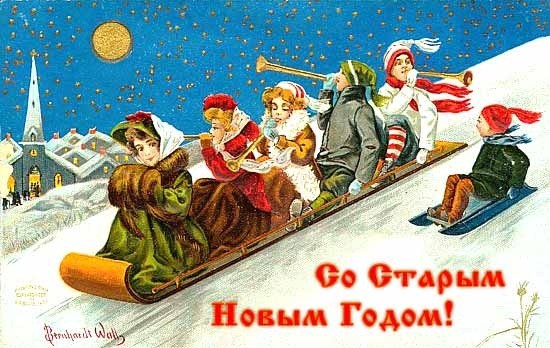
Church about Old New Year
The custom to celebrate the Old New Year on the night of January 13-14 is connected with the fact that the Russian Orthodox Church continues to celebrate both the New Year and the Nativity of Christ according to the Julian calendar, which still differs from the generally accepted gregorian calendar for 13 days. But already from March 1, 2100, this difference will be 14 days, since the difference between the Julian and Gregorian calendars increases by one day every 100 years, when the number of hundreds in a year from Christmas is not a multiple of four. Starting in 2101, Christmas and Old New Year will be celebrated a day later.
For many believers, the Old New Year is of particular importance, since they can celebrate it from the heart only after the end of the Christmas Lent, during the Holy Festivities.
Opinions of scientists about the Old New Year
Old New Year is an unscientific date, astronomers say. According to them, the strict mechanics of planetary motion forces people to make changes in the chronology. The Julian calendar, which operated in our country until 1918, is 13 days behind the Gregorian calendar, according to which Europe lives. The fact is that the Earth does not turn round its axis in exactly 24 hours. Additional seconds by this time, gradually running up, add up to days. By the beginning of the twentieth century, they turned into 13 days, which made up the difference between the old Julian and the new Gregorian systems. The new style more closely meets the laws of astronomy.
Old New Year Celebration
Despite the fact that this day is not a holiday for everyone and is not even a day off, the popularity of the Old New Year is growing. Every year, the number of people wishing to celebrate the Old New Year is increasing and is already more than 60%. Among those who are going to celebrate the “old” New Year are the majority of pupils and students, workers, entrepreneurs, housewives and, in general, people under the age of 40, with secondary specialized and secondary education, with relatively high incomes.
Traditions for the Old New Year
This day in the old days was called Vasiliev’s Day, and was crucial for the whole year. On Vasiliev Day farming holiday, which was associated with the future harvest, and performed the rite of sowing - hence the name of the holiday is "oats" or "avsen". This rite was different in different regions of the country: for example, in Tula, children scattered spring wheat around the house, while saying a prayer for a rich harvest, and the hostess then collected it and kept it until the sowing time. Ukrainian rites were distinguished by fun, dancing and songs.
And there was a kind of rite - porridge cooking. On New Year's Eve, at 2 o’clock, the eldest of the women brought cereal from the barn, and the older man brought water from a well or river. Porridge was cooked in the oven, then it was taken out and carefully examined. If the pot was just full, and the porridge rich and crumbly, then you could expect a happy year and a rich harvest - the next morning they ate such porridge. If the porridge got out of the pot, or the pot cracked, this did not bode well for the owners of the house, and then disasters were expected, and the porridge was thrown out.
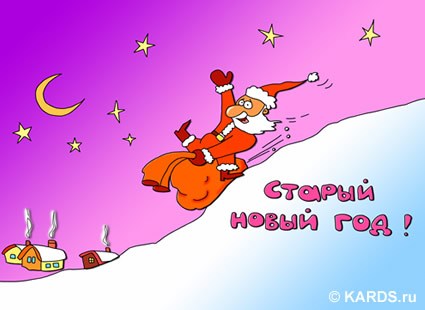
Interesting house-walking riteto enjoy pork dishes. On the night of Vasily, guests should definitely be fed pies with pork, boiled or baked pork legs and generally any dishes that include pork. A pork head was also placed on the table. The fact is that Vasily was considered a "pig" - the patron saint of pig farmers and pork products, and they believed that if there was a lot of pork on the table that night, these animals would breed in abundance and bring good profit to the owners.
And here is the tradition sculpt dumplings for the Old New Year with surprises appeared not so long ago - no one remembers exactly where and when, but many are happy to follow it. In some cities they are sculpted in almost every house - with family and friends, and then they arrange a fun feast and eat these dumplings, looking forward to whom and what kind of surprise comes across. This comic fortune-telling is especially popular with children; sometimes local dummies often produce such dumplings - just before the Old New Year.
Our country is surprising in that people here celebrate almost all the holidays, despite the beliefs. Moreover, some of them are adapted to everyday life and are not always considered religious. This article will consider the date of January 13: what holiday is celebrated on this day by Russians, as well as residents of other countries.
Orthodox church holiday
This date is very important for clergy and religious people. What exactly is celebrated on January 13, which is So, this is the day of remembrance of the Monk Melanya (first of all). However, on this day other religious figures are also honored: the holy martyr Michael, the martyr Peter, as well as St. Dositheus, Metropolitan of Zagreb.
The completion of winter Christmas time
So, on January 13, which Orthodox holiday, sorted out. They honor first of all Melania. But nevertheless, this day is most often considered as the completion of winter Christmas time. New Year's holidays end, however, young people previously allowed themselves another day to walk. In the evenings, boys and girls gathered in small companies, walked the streets, sang. In some areas of our homeland, this day is also called "Generous evening." So, young people could go home and be generous, i.e. with the help of special songs and sentences to earn yourself various goodies. Sometimes the company dressed up and in the center of the city or village arranged a small concert with dancing and dancing to the accompaniment
It is important to note that girls especially loved (and still love) this holiday. After all, it is customary to guess at Melania. Unmarried girls threw boots over their backs, counted stakes on a fence, i.e. They did everything to find out what kind of life they would have next and how soon they would be with their beloved. Fortune-telling has now changed a little, but the expected result is still the same.
Signs
It should be noted that our ancestors followed various signs. So, on Melania's day, one could guess what would happen next:
- If the sky is clear and the stars are visible on the night of January 14, a good harvest is expected this year.
- If there was a blizzard in the evening of January 13, it was believed that there would be a good harvest of nuts.
- If there will be hoarfrost on the branches on the morning of January 14, it was believed that barrels for honey should be prepared, because the year will be fruitful for this wonderful food product.
- If fog fell on the ground in the morning of January 14, the year also promised to be fruitful and rich.
- People said: those who were born in Melania or Basil (January 14) will be happy. And if they wear jasper around their neck, they are also rich.
There was also a simple custom associated with the future harvest. So, in the morning of January 14, you had to go out into the garden and eat them all. So much so that snow falls as much as possible. After all, in the fall the fruits will be showered in baskets.
Old New Year
I wonder what holiday from January 13 to January 14 the inhabitants of our country celebrate? of course! It would seem a little strange name. However, in reality it is extremely simple. The thing is that at this time earlier (according to the old calendar, old style) the arrival of the new year was celebrated. It should be clarified that this holiday appeared back in 1918, when the Gregorian calendar was introduced into everyday life (previously people used the Julian calendar). It is celebrated very widely: with festivities the night away, revelry, fun.
The rules of nutrition on this day
Having understood what holiday is celebrated on January 13-14, it is necessary to tell that at this time certain dishes should be put on the table. First of all, the so-called “generous”. It is seasoned with various dried fruits, poppy seeds and other goodies.
January 13, what holiday? Old New Year! On this day, the hostess should also treat guests with pies and pancakes. All generosity (youth who come to visit) must be given a pancake with jam to eat. By the way, with the help of pancakes you can even guess. They wrap caviar (for prosperity), meat (for well-fed life), greens (for health), cottage cheese (for fun) and lean porridge (for poverty). What kind of filling in a pancake will fall for a person, such a life awaits him throughout the year.
Slavic holidays
We further consider the date of January 13th. What holiday was celebrated on this day by our ancestors-Slavs? So, Mara Zimnaya was celebrated (or Sechenia, Chuzhenya). It was believed that it was at this time that winter fully came into its own. According to popular beliefs, this day was considered terrible for all living things. Our great-grandfathers believed that this is the blackest and most unlucky day of the year. And all because Mary’s daughters went out into the wild - Fever, Shaking, who in every possible way dirty people and even harmed their health and life.
It should be noted that little is known about this day today. They tried to talk less about him, no celebrations were held. However, if a person was dashing, then at that time he could call upon the evil forces of nature to harm his foe.
Rite on Winter Mara
We further consider the date of January 13th. What holiday did our ancestors celebrate on this day? Winter Mara, mistress of winter. One rite has survived, which certain people on this day could hold. As you know, all the forces of nature, both bad and good, must be respected. And for this there were special people. They also honored Maru. To do this, it was necessary to find a fallen tree in the forest, a dog skull was laid at its foot, and animal skins tied to branches. They presented Mara with boiled eggs and unleavened cakes, chopped on the so-called Navi bones, i.e. sharpened pegs. At this time, they read special spells and poems. And all so that the Winter Mara does not get angry with people and does not spoil their lives.
Other holidays that are celebrated on this day in the Russian Federation
January 13, what holiday in Russia is still customary to celebrate? Day of the Russian press. It was on January 13, back in 1703, the first printed newspaper, Vedomosti, was published. However, it is important to note that she did not have a permanent name. Sometimes the newspaper was called "Russian Vedomosti", "Vedomosti Moscow" (if it was only about Moscow news), etc. The first issue described the military and political affairs of the whole country.
We further consider the date of January 13th. What holiday in Russia is celebrated today? It should be noted that the Day of the Russian Press was established not so long ago - in 1991. And the holiday came to replace the Day of Soviet Press, which was celebrated on May 5.
It is also important to note that on this day the most active figures of the Russian media are awarded. Interestingly, in 2010, approximately 47 thousand different newspapers and magazines were registered in Russia. And by 2015, their number has almost doubled.
Other holidays and days
- This is the day of the greatest prophet Muhammad. To be precise, the date of its birth is unknown. They mark the day when the prophet died. That is why the date itself is celebrated with a certain amount of sadness. This day is called Mawlid al-Nabi. In Tunisia, Morocco, Algeria and Syria celebrate it very widely.
- January 13, what is a divine holiday in India? So, there they worship the goddess Lori. At this time, bonfires are lit throughout North India to mark the end of a harsh winter. The arrival of Lori is usually celebrated by fasting and gifts to each other. And in the evening it is allowed to organize a feast with many delicacies and dishes. Also on this day you can see a special Indian dance of Bhangra, which is attended exclusively by men.
- January 13, what church holiday does the Swedes have? So it's Tjugondag Knut Day. At this time, marks the end of the Christmas festivities. The first word in the name of the holiday is literally translated as "twenty", i.e. twenty days have passed since. The scenario of the celebration varies depending on the area. For example, in the southern part of the country, a straw scarecrow the size of a person is burned.
- Memorial Day in Lithuania. In this country, January 13 is the Day of Remembrance of all defenders of freedom.
January 14 - Vasily's Day
So, on January 13, what an Orthodox holiday, of course. This is Melania's day. But on January 14, the Russian Orthodox Church honors Basil the Great. It’s popularly called Vasily’s Day, or Ovsen. From this date people finished festivities and went to get a job.
Old New Year - customs, traditions, congratulations, fortune telling. A PHOTO. VIDEO
How to celebrate the Old New Year? How to congratulate relatives, friends and relatives? How to use the magic of the Old New Year to find out the future?
The tradition of celebrating the Old New Year has developed relatively recently - during the transition in 1918 from Julian to gregorian calendar. This discrepancy is 13 days.
With the transition to a new reckoning, the date of the beginning of the New Year has changed. January 1, according to the "new style," falls on December 19 according to the Julian calendar, and January 14, according to the "new style", is January 1 according to the Julian calendar. In the Orthodox church life, no changes have occurred. The Orthodox Church did not go over to the Gregorian calendar.
On January 14 (January 1, old style) the Christian church also honors the memory of the saint - the author of many. In the old days this day was called Vasiliev’s Day and was crucial for the whole year. The evening before (now - January 13) was called Vasilyev evening.
Old New Year is celebrated not only in Russia and a number of CIS republics.
The tradition of celebrating the Old New Year is preserved in Serbia and Montenegroas the Serbian Orthodox Church continues to live according to the Julian calendar. They call it differently, the Serbs - "Serbian New Year" or Little Christmas. In Montenegro, it is customary to call this holiday "The Rights of Nova Godina", which means "the right New Year." Basilits are prepared for the Old New Year: round pies from corn dough with kaymak - cream, curdled like cheese. Sometimes they cook another dish from corn dough - a pair of steaks. Old New Year is celebrated in Macedonia.
IN Greece this holiday is called St. Basil's Day. In anticipation of this saint, Greek children leave their shoes by the fireplaces so that St. Basil puts gifts in them.
IN Romania Old New Year is celebrated most often in a narrow circle of families. For the festive table, New Year's cakes are made with surprises: coins, porcelain figurines, rings, hot peppers. The ring found in the pie promises great luck.
Old New Year is also celebrated in the northeast. Switzerland in some German-speaking cantons. The inhabitants of the canton of Appenzel in the XVI century did not accept the reform of Pope Gregory and still celebrate the holiday on the night of January 13-14. January 13, they celebrate the old day of St. Sylvester, who, according to legend, in 314 caught a terrible monster. It was believed that in 1000 the monster would break free and destroy the world, but this did not happen. Since then, on New Year's Day, residents of Switzerland dress up in fancy dresses, put on fancy constructions resembling doll houses or botanical gardens on their heads, and call themselves Sylvester Claus.
Old New Year celebrated in a small Welsh community in Wales in the West of Great Britain - on January 13th they celebrate Hyun Galan. In the United Kingdom, the Gregorian calendar has been in effect since 1752, but a small community of Welsh farmers with a center in a village called Guane Valley celebrates the beginning of the New Year according to the Julian calendar. "Hyun Galan" is met according to the traditions of the ancestors by songs, carols and local home-made beer. For locals, Hyun Galan is a celebration of good neighborliness and open doors.
Fortune telling for Old New Year
Old New Year is traditionally a time for fortune telling and magic. The time on the night of January 13 to January 14 is magical, when almost any object can become a sign, and an event is a prediction of the future.
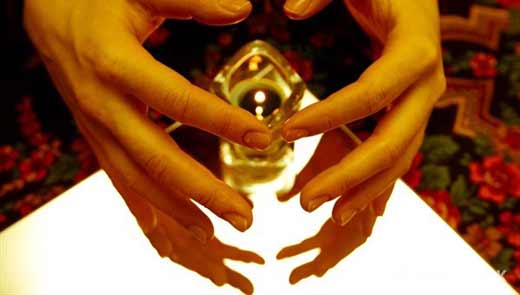
The method of fortune telling proved by centuries - wax candles.
For its holding, church candles are usually used. It is necessary to melt a piece of a candle in another flame - for example, in an ordinary tablespoon. The molten wax is poured into a pre-prepared cup with water. When it hardens, you need to consider the resulting pattern.
The main thing is the shape of the figure. If it is round, this is a good sign. Man will be lucky. If there are a lot of “sharp” elements, then he has enemies and envious people.
Symbolic figures are sure to predict something for the coming year. Wax threads - waiting for you to travel or road. Wax is curled in round drops-coins - the year will be monetary-profitable. Wax forms a cross - to the diseases of you or your loved ones. It turns out the face - this year marriage is possible or the groom will appear. Asterisks - to success or success. A month is for reflection and expectations.
How to celebrate the Old New Year
On the New Year's Eve, girls spend fortune-telling on the groom (narrowed). You need to get a wedding ring from a married lady. Only from hand to hand it can not be transferred. This is a bad omen: it is believed that if a girl takes her wedding ring from the hands of a married lady, then fate will give her only an unfree lover, and the lady will divorce. Therefore, it is better if the mistress of the ring will participate in fortune telling.
But fortune telling is carried out like this. You need to prepare cups, one per girl. The married lady should place them upside down on the table. Put a ring under one. Naturally, everything needs to be done so that none of the girls sees the preparation process. Now fortunetellers should choose a cup for themselves. Not necessarily different. It is quite possible to make one. When all the girls have decided, the secret of the location of the ring is revealed. The one who made the cup, under which it was, can wait for the marriage proposal in the new year.
Fortune telling
there is fortune telling about future husband. Various objects are put on a tray: a piece of bread, a glass, a coin (iron ruble), a mirror, a coal, and so on. The tray is covered with a clean towel (preferably linen). The girls take turns approaching the tray, stick their hand under the towel and randomly stretch the item. Bread - the husband will be working, the mirror - the beauties are written, the coin - the rich, the glass - the drunkard, the coal - the poor.
there is fortune telling in a dream. Many girls can see their betrothed, but he will come for a reason - you need to call him correctly. For example, you can put four card kings under the pillow. When falling asleep, one must condemn and ask the betrothed to come in a dream. Belief says that, after conducting such a fortune-telling, in a dream a girl should see her fiance in the image of one of the kings.
If you have a boyfriend who is sweethearted, then you can put only a king of diamonds under your pillow and ask a question on a magical night that will relate directly to this guy. In a dream you should see the answer to this question.
With the help of fortune telling about the future, you can find out the name of the future spouse. In the evening of January 13, take small leaves and write on them different male names. Now mix the leaves and place them under the pillow. When you wake up in the morning, first pull out a piece of paper. The name you see will be the name of the narrowed one.
Old custom - fortunetelling at food. For the New Year’s, dumplings with potatoes are being prepared. And some of them come with a surprise. Usually put a coin, salt, sugar, pepper, a handful of rice, peas, a piece of walnut.
I came across a sweet dumpling - the year will be good, fruitful, joyful. It comes across salty - tears and strength tests await. Dumpling with rice - to prosperity, good yields, addition to the family. Dumpling with peas - for travel, or even moving. A walnut will crack on your teeth - the year will be cash, rich. Perhaps a rich groom will appear (it depends on who gets the nut). The coin clanks on the tooth - you will not have time to count the money.
Fortune telling for Old New Year
Happy New Year
SMS Congratulations on Old New Year:
♦ Congratulations on the most mysterious holiday - the old New Year. And let it nevertheless really be new and bring new successes, undertakings, gifts, joyful moments and a happy peaceful life!
♦ Happy New Year! May this year give only fun, joy, good luck, new opportunities and prospects. I wish that the problems ceased to disturb, health strengthened, and family and friends were always there. Happy holiday!
♦ An excellent occasion to spend with the Old New Year all adversities, problems, diseases. May they never return to our lives. Let's remember only all the good things that were!
♦ Seeing off Old year, I wish, without worries, to remember all your dreams, plans, goals, achievements, books, films, birthdays. With gratitude for the past, step boldly into the future, because in the New Year everything will be two better and brighter.
♦ Today is a holiday again! And although the main fireworks have already died down, gifts have been given and received, we have a reason to congratulate each other once again on the New Year. Make your cherished desires, if you do not have time to dream - dream! May everything that you expect be done in the coming year!
Happy New Year video greetings:
Happy New Year
Happy New Year Greetings:
♦ This Old New Year
Let everything be famously carried away
Let the beaten track
Will bring a little good.
Let him notice you at home.
What comes with a smile:
Joy, happiness and fun
Great mood.
Let him add a bucket of strength
The world to be friendly to you,
So there is no sadness
To nerves only grow stronger
To make profits grow,
To bring frost
Only vigor for success
You love, luck and laughter!
♦ This Old New Year
I want to wish you again
May he bring happiness
They will all be healthy.
May your dreams come true
And your desires
To life on all sides
Becomes more beautiful!
♦ Old New Year - Hooray!
It's time to celebrate again.
The chiming clock will be repeated
And the wish will come true.
Pour into a glass of wine
Drink it to the bottom.
It’s so customary in the country,
Celebrate the holiday doubly.
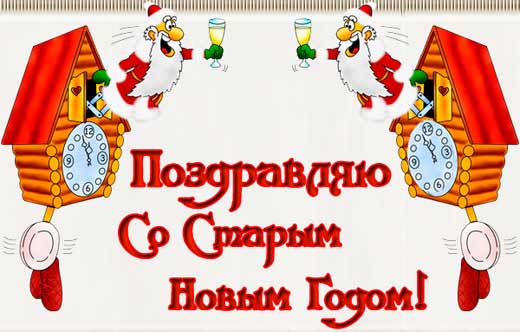
♦ The New Year is coming!
I wish everyone happiness and good luck,
Long years, health and kindness.
Let the misfortunes go away soon.
♦ Congratulations on the holiday I am you!
Let the road be smooth in life.
Old New Year let it bring
There are a lot of joys, smiles.
♦ Olivier, feast, toasts,
The mummers go to visit.
Deja vu? Or maybe not?
Old New Year, hello!
Take it, friends,
Congratulations from me.
Do not grow old with all my soul,
Have fun, sing songs.
Festive mood
You to the very baptism.

Funny congratulations on the Old New Year:
♦ Two weeks passed -
Hello again, New Year!
Just ate everything -
People celebrate again.
Someone holding on to the liver
And in the morning the Borjomi drinks
But the 13th has arrived
Case in the evening - and here
We raise our glasses
For luck, for love
We wish you happiness, joy
To come to you again and again
Money puffy bags
So that you do not know adversity,
So that we meet with you more than once
Good old New Year!
♦ Two weeks have passed,
They drank and ate everything,
It seems the people left ...
Bam! And again New Year!
♦ We ate and did not sleep,
New Year we celebrated.
And not a bit tired
For they danced merrily.
Ahead is still waiting for us
Good Old New Year.
May he not be bored
New notes with us.
♦ New Year - it's for fun!
An old holiday is for a hangover.
Congratulations on this and that,
We will be in time, we will note everything!
Let there be a lot of luck
Luckily we will find the way!
♦ May this Old New Year
Junk will take everything with him
Leaving the "old" only one
Your beloved wife!
♦ We didn’t catch our breath,
Holiday again, songs, dances,
Old New Year is coming.
Have fun honest people!
"Sales of dreams", love, health
And a good feast!

Congratulatory carols for Old New Year:
♦ Sow-sow-sow,
Happy New Year! Congratulations.
Give the ruble or nickel -
We will not leave here like that.
♦ I sow, I believe, I sow,
Happy New Year!
On New Year, on new happiness
Freak Wheat
Peas, lentils!
In the field - in shovels,
On the table - pies!
♦ We sow, wee, sow,
Happy New Year! Congratulations!
Though the old New Year -
Anyway, good bears!
We wish the old fashioned way
Fertility - cattle,
Warm booths - little dog,
Saucer of milk - a kitten,
A handful of wheat - a cockerel,
The red girl is a friend
Small children - dad with mom,
Grandmother - the granddaughter of small!
Sowing, blowing, sowing,
Happy New Year! Congratulations!
Open the chest
Get a piglet!



